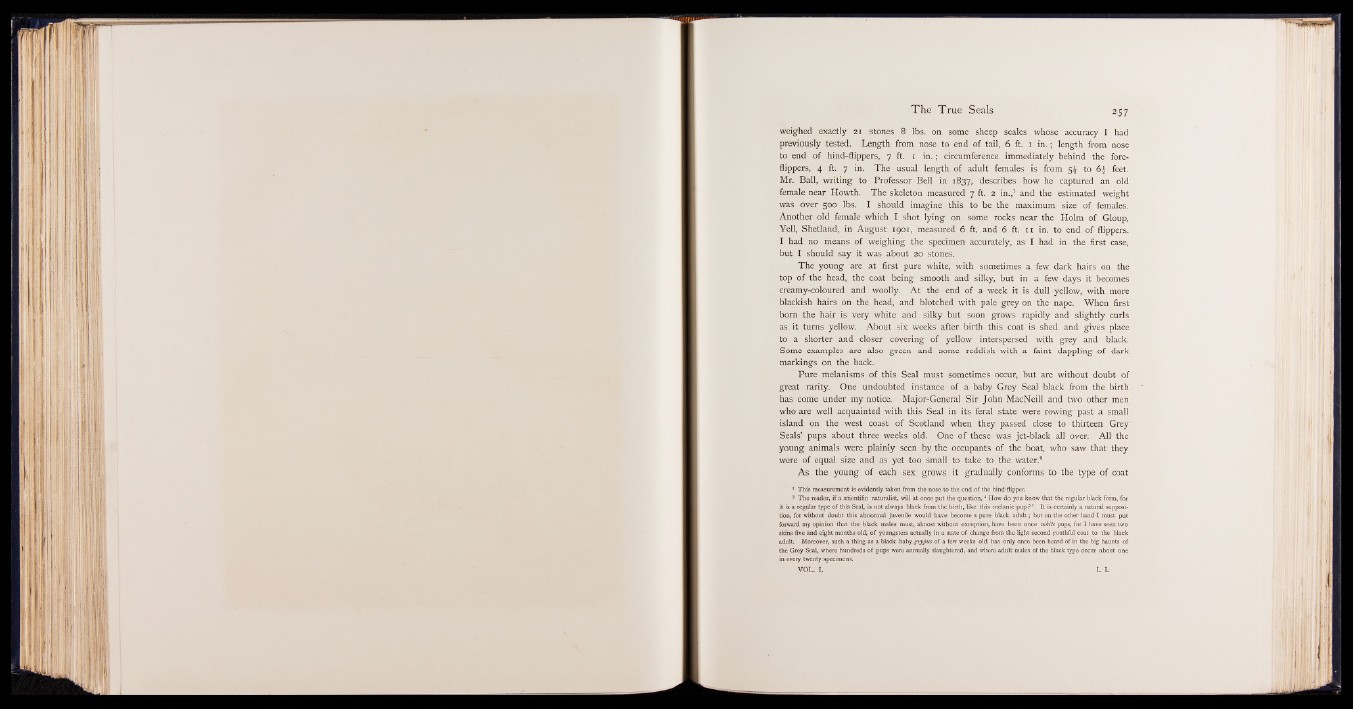
weighed exactly 21 stones 8 lbs. on some sheep scales whose accuracy I had
previously tested. Length from nose to end of tail, 6 ft. 1 in.; length from nose
to end of hind-flippers, 7 ft. 1 in .; circumference immediately behind the foreflippers,
4 ft. 7 in. The usual length of adult females is from 5^ to 6£ feet.
Mr. Ball, writing to Professor Bell in 1837, describes how he captured an old
female near Howth. The skeleton measured 7 ft. 2 in.,1 and the estimated weight
was over 500 lbs. I should imagine this to be the maximum size of females.
Another old female which I shot lying on some rocks near the Holm of Gloup,
Yell, Shetland, in August 1901, measured 6 ft. and 6 ft. 11 in. to end of flippers.
I had no means of weighing the specimen accurately, as I had in the first case,
but I should say it was about 20 stones.
The young are at first pure white, with sometimes a few dark hairs on the
top of the head, the coat being smooth and silky, but in a few days it becomes
creamy-coloured and woolly. At the end of a week it is dull yellow, with more
blackish hairs on the head, and blotched with pale grey on the nape. When first
born the hair is very white and silky but soon grows rapidly and slightly curls
as it turns yellow. About six weeks after birth this coat is shed and gives place
to a shorter and closer covering of yellow interspersed with grey and black.
Some examples are also green and some reddish with a faint dappling of dark
markings on the back.
Pure melanisms of this Seal must sometimes occur, but are without doubt of
great rarity. One undoubted instance of a baby Grey Seal black from the birth
has come under my notice. Major-General Sir John MacNeill and two other men
who are well acquainted with this Seal in its feral state were rowing past a small
island on the west coast of Scotland when they passed close to thirteen Grey
Seals’ pups about three weeks old. One of these was jet-black all over; All the
young animals were plainly seen by the occupants of the boat, who saw that they
were of equal size and as yet too small to take to the water.2
As the young of each sex grows it gradually conforms to the type of coat
1 This measurement is evidently taken from the nose to the end of the hind-flipper.
2 The reader, if a scientific naturalist, will at once put the question, ‘ How do you know that the regular black form, for
it is a regular type of this Seal, is not always black from the birth, like this melanic pup ? ’ It is certainly a natural supposition,
for without doubt this abnormal juvenile would have become a pure black adult; but on the other hand I must put
forward my opinion that the black males must, almost without exception, have been once white pups, for I have seen two
skins five and eight months old, of youngsters actually in a state of change from the light second youthful coat to the black
adult. Moreover, such a thing as a black baby grypus of a few weeks old has only once been heard of in the big haunts of
the Grey Seal, where hundreds of pups were annually slaughtered, and where adult males of the black type occur about one
in every twenty specimens.
VOL. I. L L